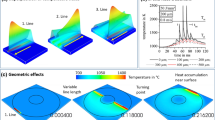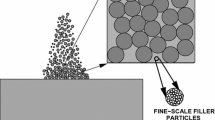Abstract
Additive manufacturing of metals produces material microstructures which are inherently different from those of wrought materials as they arise from a complex temperature history associated with the additive process. Because of complex microstructure morphologies and spatial heterogeneities, material properties are heterogeneous and reflect underlying microstructure. This paper describes a workflow for simulating the dynamic and spall response of additively manufactured metals. The approach consists of simulating microstructures associated with the additive manufacturing process, methods for representing spatially heterogeneous microstructures on a peridynamics discretization, and a specialized material model for handling dynamic material failure under spall conditions. Material properties are spatially distributed onto the discretization so that microstructure effects arising from additive manufacturing can be systematically incorporated into engineering-scale calculations. Model simulations are compared with laboratory flyer plate test data.



















Similar content being viewed by others
References
Adams DP, Reedlunn B, Maguire MC, Song B, Carroll J, Bishop JE, Wise JL, Kilgo A, Palmer TA, Brown DW, Clausen B (2019) Mechanical response of additively manufactured stainless steel 304L across a wide range of loading conditions. Tech. Rep. SAND2019-7001, Sandia National Laboratories
Mitchell JA, Tikare V (2016) A model for grain growth during welding. Sandia National laboratory (US) SAND2016-11070
Plimpton S, Battaile C, Chandross M, Holm L, Tikare V, Wagner G, Webb E, Zhou X (2009) Crossing the mesoscale no-man’s land via parallel kinetic Monte Carlo. Tech. Rep. SAND2009-6226, Sandia National Laboratories
Rodgers TM, Madison JD, Tikare V, Maguire MC (2016) Predicting mesoscale microstructural evolution in electron beam welding. JOM 68(5):1419–1426
Peebles P, Shaviv G (1982) The large-scale structure of the universe
Blair SC, Berge PA, Berryman JG (1996) Using two-point correlation functions to characterize microgeometry and estimate permeabilities of sandstones and porous glass. J Geophys Res Solid Earth 101(B9):20359–20375
Karsanina MV, Gerke KM, Skvortsova EB, Mallants D (2015) Universal spatial correlation functions for describing and reconstructing soil microstructure. PLoS ONE 10(5):e0126515
Adams BL, Kalidindi S, Fullwood DT, Fullwood D (2012) Microstructure sensitive design for performance optimization. Butterworth-Heinemann
Cecen A, Yabansu YC, Kalidindi SR (2018) A new framework for rotationally invariant two-point spatial correlations in microstructure datasets. Acta Mater 158:53–64
Gokhale A, Tewari A, Garmestani H (2005) Constraints on microstructural two-point correlation functions. Scripta Mater 53(8):989–993
Gokhale AM (2004) Experimental measurements and interpretation of microstructural n-point correlation functions. Microsc Microanal 10(S02):736–737
Jiao Y, Stillinger F, Torquato S (2007) Modeling heterogeneous materials via two-point correlation functions: Basic principles. Phys Rev E 76(3):031110
Sun Y, Cecen A, Gibbs JW, Kalidindi SR, Voorhees PW (2017) Analytics on large microstructure datasets using two-point spatial correlations: Coarsening of dendritic structures. Acta Mater 132:374–388
Tewari A, Gokhale A, Spowart J, Miracle D (2004) Quantitative characterization of spatial clustering in three-dimensional microstructures using two-point correlation functions. Acta Mater 52(2):307–319
Paulson NH, Priddy MW, McDowell DL, Kalidindi SR (2017) Reduced-order structure-property linkages for polycrystalline microstructures based on 2-point statistics. Acta Mater 129:428–438
Mura T (1987) Micromechanics of Defects in Solids, 2nd edn. Kluwer Academic Publishers
Nemat-Nasser S (2004) A Treatise on Finite Deformation of Heterogeneous Inelastic Materials. Cambridge University Press
Ruggles T, Cluff S, Miles M, Fullwood D, Daniels C, Avila A, Chen M (2016) Ductility of advanced high-strength steel in the presence of a sheared edge. JOM 68(7):1839–1849
Castillo A, Mitchell JA, Bond S (2016) Using and developing novel data analytics for digitalized microstructures. Tech. Rep. SAND2016-12140, Sandia National Laboratories
Generale AP, Kalidindi SR (2021) Reduced-order models for microstructure-sensitive effective thermal conductivity of woven ceramic matrix composites with residual porosity. Compos Struct 274:114399
Baniassadi M, Garmestani H, Li D, Ahzi S, Khaleel M, Sun X (2011) Three-phase solid oxide fuel cell anode microstructure realization using two-point correlation functions. Acta Mater 59(1):30–43
Fullwood DT, Niezgoda SR, Kalidindi SR (2008) Microstructure reconstructions from 2-point statistics using phase-recovery algorithms. Acta Mater 56(5):942–948
Gommes CJ, Jiao Y, Torquato S (2012) Microstructural degeneracy associated with a two-point correlation function and its information content. Phys Rev E 85(5):051140
Kumar H, Briant C, Curtin W (2006) Using microstructure reconstruction to model mechanical behavior in complex microstructures. Mech Mater 38(8–10):818–832
Sheehan N, Torquato S (2001) Generating microstructures with specified correlation functions. J Appl Phys 89(1):53–60
Kim SY, Kim JS, Lee JH, Kim JH, Han TS (2021) Comparison of microstructure characterization methods by two-point correlation functions and reconstruction of 3D microstructures using 2D TEM images with high degree of phase clustering. Mater Charact 172:110876
Brown AD, Wayne L, Pham Q, Krishnan K, Peralta P, Luo SN, Patterson BM, Greenfield S, Byler D, McClellan KJ et al (2015) Microstructural effects on damage nucleation in shock-loaded polycrystalline copper. Metall and Mater Trans A 46(10):4539–4547
Nguyen T, Luscher DJ, Wilkerson JW (2019) The role of elastic and plastic anisotropy in intergranular spall failure. Acta Mater 168:1–12
Wayne L, Krishnan K, DiGiacomo S, Kovvali N, Peralta P, Luo S, Greenfield S, Byler D, Paisley D, McClellan K et al (2010) Statistics of weak grain boundaries for spall damage in polycrystalline copper. Scripta Mater 63(11):1065–1068
Plimpton S, Thompson A, Slepoy A (2022) SPPARKS. URL https://spparks.github.io/
Rodgers TM, Madison JD, Tikare V (2017a) Simulation of metal additive manufacturing microstructures using kinetic Monte Carlo. Comput Mater Sci 135:78–89
Rodgers TM, Mitchell JA, Tikare V (2017b) A Monte Carlo model for 3D grain evolution during welding. Model Simul Mater Sci Eng 25(6):1–22
Pedregosa F, Varoquaux G, Gramfort A, Michel V, Thirion B, Grisel O, Blondel M, Prettenhofer P, Weiss R, Dubourg V, Vanderplas J, Passos A, Cournapeau D, Brucher M, Perrot M, Duchesnay E (2011) Scikit-learn: Machine learning in Python. J Mach Learn Res 12:2825–2830
Wise JL, Adams DP, Nishida EE, Song B, Maguire MC, Carroll J, Reedlunn B, Bishop JE, Palmer T (2017) Comparative shock response of additively manufactured versus conventionally wrought 304L stainless steel. In: AIP Conference Proceedings, AIP Publishing, vol 1793, URL https://doi.org/10.1063/1.4971640
Barker LM, Hollenbach RE (1972) Laser interferometer for measuring high velocities of any reflecting surface. J Appl Phys 43(11):4669
Zocher MA, Maudlin PJ, Chen SR, Flower-Maudlin EC (2000) An evaluation of several hardening models using Taylor cylinder impact data. Tech. Rep. LA-UR-00-1192, Los Alamos National Laboratory, Los Alamos, NM
Silling SA (2019) Spall kinetics model description. Tech. Rep. SAND2019-10345, Sandia National Laboratories, Albuquerque, NM (United States)
Specht PE, Mitchell JA, Adams DP, Brown J, Silling SA, Wise JL, Palmer T (2019) Shortening the design and certification cycle for additively manufactured materials by improved mesoscale simulations and validation experiments: Fiscal year 2019 status report. Tech. Rep. SAND2019-12275, Sandia National Laboratories, Albuquerque, NM
Silling SA, Askari E (2005) A meshfree method based on the peridynamic model of solid mechanics. Comput Struct 83:1526–1535
Johnson GR, Cook WH (1983) A constitutive model and data for metals subjected to large strains, high strain rates and high temperatures. In: Proceedings of the 7th International Symposium on Ballistics, pp 541–547
Foster JT, Silling SA, Chen WW (2010) Viscoplasticity using peridynamics. Int J Numer Meth Eng 81(10):1242–1258
Silling SA (2017) Stability of peridynamic correspondence material models and their particle discretizations. Comput Methods Appl Mech Eng 322:42–57
Warren TL, Silling SA, Askari A, Weckner O, Epton MA, Xu J (2009) A non-ordinary state-based peridynamic method to model solid material deformation and fracture. Int J Solids Struct 46(5):1186–1195
Silling SA, Parks ML, Kamm JR, Weckner O, Rassaian M (2017) Modeling shockwaves and impact phenomena with eulerian peridynamics. Int J Impact Eng 107:47–57
Somasundaram D, Roy S, Trabia M, O’TOOLE B, HIXSON R (2015) Parametric sensitivity comparison of simulation models for flyer plate impact experiments. International Journal of Computational Methods and Experimental Measurements 3(4):305–315
Acknowledgements
The authors gratefully acknowledge funding and support from the Advanced Certification and Qualification (ACQ) program. Sandia National Laboratories is a multimission laboratory managed and operated by National Technology & Engineering Solutions of Sandia, LLC, a wholly owned subsidiary of Honeywell International Inc., for the U.S. Department of Energy’s National Nuclear Security Administration under contract DE-NA0003525. This paper describes objective technical results and analysis. Any subjective views or opinions that might be expressed in the paper do not necessarily represent the views of the U.S. Department of Energy or the United States Government.
Author information
Authors and Affiliations
Corresponding author
Additional information
Publisher’s Note
Springer Nature remains neutral with regard to jurisdictional claims in published maps and institutional affiliations.
Rights and permissions
About this article
Cite this article
Mitchell, J.A., Silling, S.A., Chiu, E. et al. Modeling Additively Manufactured Metallic Microstructures for Dynamic Response. J Peridyn Nonlocal Model 5, 497–520 (2023). https://doi.org/10.1007/s42102-022-00093-2
Received:
Accepted:
Published:
Issue Date:
DOI: https://doi.org/10.1007/s42102-022-00093-2




